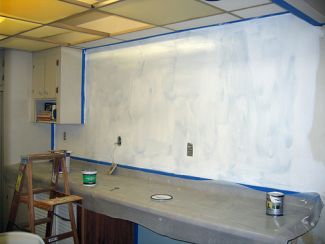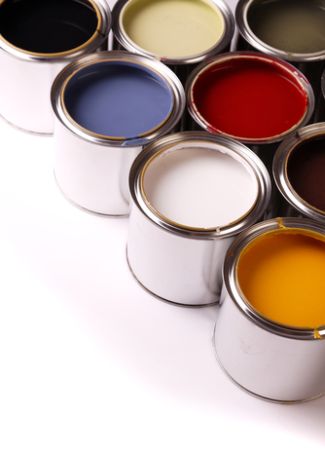Common DIY Painting Mistakes and Professional Tips on Avoiding Them, Part 3

This is a 3-article series, containing a total of 11 important house painting tips and tricks from professional painter Bruce Scofield. See the first 2 installments here: painting techniques, part 1, and DIY painting tips part 2. Continuing on in our final article, we come to mistake #9…
Mistake #9: Using the wrong paint finish or the wrong roller cover.
Why it’s bad: You will end up with a compromised finished product or spend extra time and money painting an additional coat.
Do this instead: Choose the finish of your paint according to the surface being covered. There are six paint finishes, covering a spectrum from most shiny to least: gloss, semi-gloss, satin, eggshell, matte, and flat. Generally speaking when painting interior spaces, Bruce recommends eggshell finish for walls (it can be cleaned easier than flat, yet is not too shiny) and semi-gloss for trim. Using semi-gloss on the walls of your home will give it an industrial feel. Of course, there is a lot of leeway for specific situations, and your local paint supplier is usually a wealth of information on what type of paint to use. Remember, shinier paint will cause more surface imperfections will show. However, a glossy finish can be perfect for a nice book shelf or piece of furniture.
The length of the nap on a roller has to fit the surface being painted, as well as the paint finish. Use a ½ inch roller cover for flat paint and 3/8 inch for semi-gloss and small foam rollers are great for a smooth glossy paint finish. Also keep in mind you will need a longer nap to paint a rougher surface texture, for instance a textured ceiling.
Mistake #10: Incorrect use of primer.
 Why it’s bad: Your expensive finish paint will soak in too much, not adhere well, or absorb unevenly.
Why it’s bad: Your expensive finish paint will soak in too much, not adhere well, or absorb unevenly.
Do this instead: The purpose of primer is to seal porous surfaces and create a uniform layer, to which your finish paint will evenly absorb and readily adhere. Always use primer when painting over the following surfaces: raw or unfinished material, latex paint with a sheen finish (only latex flat finish doesn’t need primer), oil-based paint, and joint compound. You may need to sand wood very lightly with fine grit sandpaper (#150 or finer) if the wood grain lifts up from the surface after the first coat of primer is applied. Patches of joint compound will show through a finished coat by displaying a different sheen if you don’t prime them. Bruce recommends dabbing two coats of primer on patches, allowing drying time in between while working on other tasks. When appropriate, use a small roller for this job and have the roller texture match the rest of the wall.
If you are covering a surface permeated with smoke, oil primer is necessary; be sure to use a quality respirator when applying any oil based product. Also, take advantage of specialty primers made to accommodate various surface applications, for instance to block stains or resist mildew potentially found in damp areas such as basements or bathrooms.
Mistake #11: Expecting more color coverage than is realistic for bold colors.
 Why it’s bad: You may underestimate the amount of paint and time required to complete the job.
Why it’s bad: You may underestimate the amount of paint and time required to complete the job.
Do this instead: If painting a pastel color over a dark color, paint at least one, or if necessary, two coats of white first. This is the only way to get your true color. If painting an intense color such as red or orange, first paint a base coat of neutral gray. Many bright colors have little covering power so you may need to experiment a little to get the effect you want.
That’s the last of our 11 tips from painter Bruce Scofield. He has a lot of tricks in his painter’s cap; pull some out and put them to good use on your next DIY project. They are tried and true methods that will improve your painting proficiency.
Bruce: Please accept our sincere appreciation for sharing this excellent painting advice from the wealth of experience you have accumulated over your long professional career. We have seen your work firsthand and attest to the fine finished surfaces that are the result of your knowledge and capability!
Image source quirky
 The Common DIY Painting Mistakes and Professional Tips on Avoiding Them, Part 3 by Water Damage Defense, is licensed under a Creative Commons Attribution-ShareAlike 3.0 Unported License.
The Common DIY Painting Mistakes and Professional Tips on Avoiding Them, Part 3 by Water Damage Defense, is licensed under a Creative Commons Attribution-ShareAlike 3.0 Unported License.
